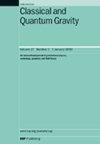Searches for compact binary coalescence events using neural networks in LIGO/Virgo third observation period
IF 3.6
3区 物理与天体物理
Q2 ASTRONOMY & ASTROPHYSICS
引用次数: 0
Abstract
We present the results on the search for the coalescence of compact binary mergers using convolutional neural networks (CNNs) and the LIGO/Virgo data for the O3 observation period. Two-dimensional images in time and frequency are used as input. The analysis is performed in three separate mass regions covering the range for the masses in the binary system from 0.2 M to 100 M , excluding very asymmetric mass configurations. We explore neural networks trained with input information from pairs of interferometers or all three interferometers together, concluding that the use of the maximum information available leads to an improved performance. A scan over the O3 data set, using the CNNs, is performed with different false rate thresholds for claiming detection of at most one event per year or at most one event per week. The latter would correspond to a loose online selection still leading to affordable false alarm rates. The efficiency of the neutral networks to detect the O3 catalog events is discussed. In the case of a false rate threshold of at most one event per week, the scan leads to the detection of about 50% of the O3 catalog events. Once the search is limited to the catalog events within the mass range used for neural networks training, the detection efficiency increases up to 70 . Further improvement in search efficiency, using the same type of algorithms, will require the implementation of new criteria to suppress the remaining major background sources.在 LIGO/Virgo 第三观测期利用神经网络搜索紧凑双星凝聚事件
我们介绍了利用卷积神经网络(CNN)和 O3 观测期 LIGO/Virgo 数据搜索紧凑型双星并合凝聚的结果。以时间和频率的二维图像作为输入。分析在三个独立的质量区域进行,涵盖了双星系统从 0.2 M 到 100 M 的质量范围,不包括质量极不对称的配置。我们探索了使用成对干涉仪或所有三个干涉仪的输入信息训练的神经网络,得出的结论是使用可用的最大信息可以提高性能。使用 CNN 对 O3 数据集进行扫描时,采用了不同的误报率阈值,即每年最多检测到一个事件或每周最多检测到一个事件。后者相当于一种宽松的在线选择,但仍能达到可承受的误报率。讨论了中性网络探测 O3 星表事件的效率。在误报率阈值为每周最多一个事件的情况下,扫描可以检测到大约 50%的 O3 星表事件。一旦搜索仅限于用于神经网络训练的质量范围内的目录事件,检测效率将提高到 70%。要利用同类算法进一步提高搜索效率,就需要采用新的标准来抑制剩余的主要背景源。
本文章由计算机程序翻译,如有差异,请以英文原文为准。
求助全文
约1分钟内获得全文
求助全文
来源期刊

Classical and Quantum Gravity
物理-天文与天体物理
CiteScore
7.00
自引率
8.60%
发文量
301
审稿时长
2-4 weeks
期刊介绍:
Classical and Quantum Gravity is an established journal for physicists, mathematicians and cosmologists in the fields of gravitation and the theory of spacetime. The journal is now the acknowledged world leader in classical relativity and all areas of quantum gravity.
 求助内容:
求助内容: 应助结果提醒方式:
应助结果提醒方式:


